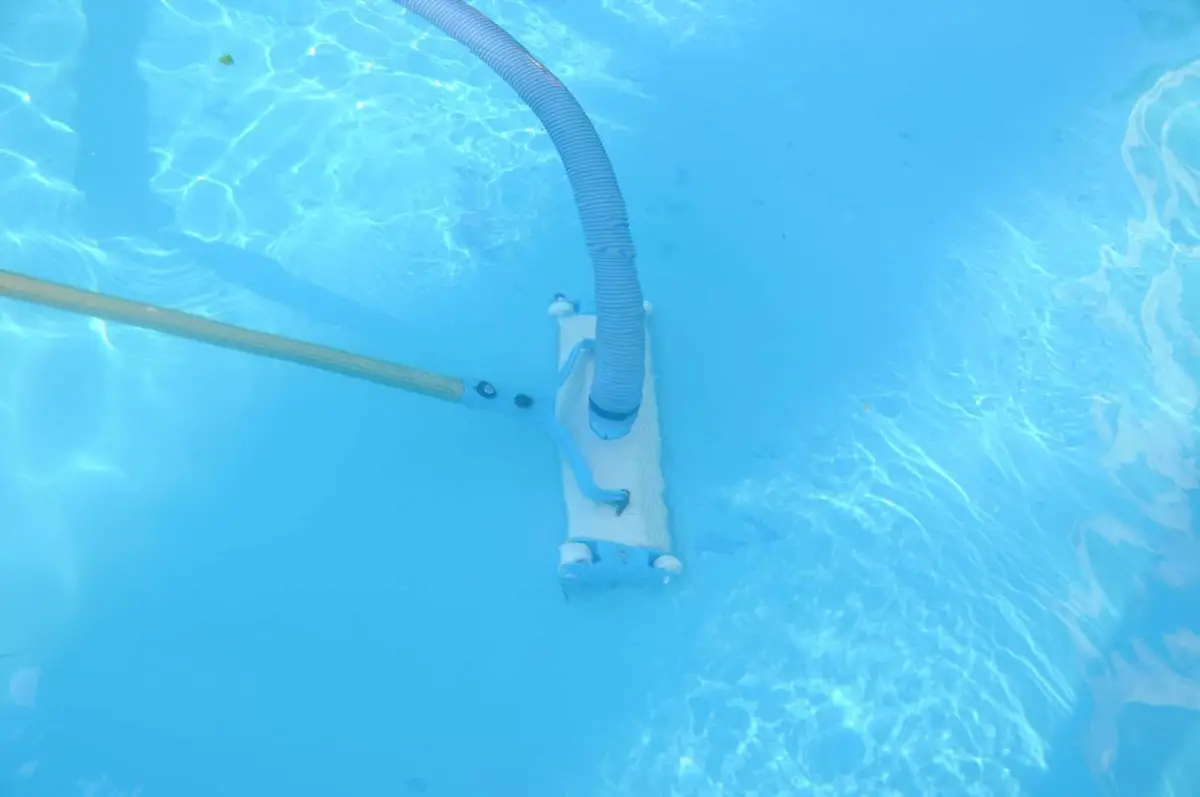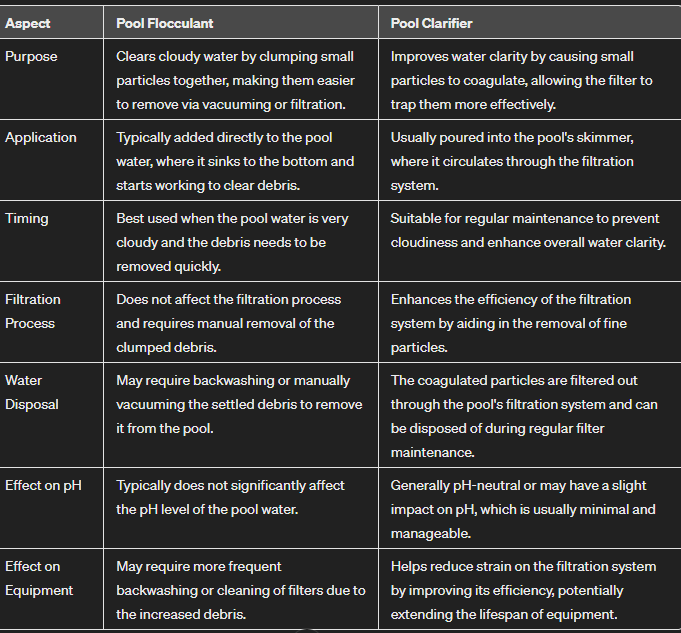After shocking your pool you need to add a small amount of Pool Clarifier that will polish and help your filter clean Pool’s water more efficiently along with a good quality Pool Flocculant that works in tangent with a Clarifier during those times when your pool is in trouble or vulnerable to usage and temperature. Each product has an important function. What is the difference between Pool Clarifiers and Pool Flocculants?
Pool clarifiers do not work as quickly as flocculents they are used more for routine maintenance or polishing H2O instead of troubleshooting a problem with the pool water. Flocculents on the other hand work much faster, because they drop the suspended debris to the pool floor before you manually vacuum the debris to waste.
Using a Clarifier product along with Pool Flocculants should be part of a pool regular maintenance program and the best way to keep your pool and filtering system’s overall condition and health operating smoothly when you need your pool open during those hot summer days that are coming.
Pool Flocculant vs Clarifier
Pool clarifier products are polymers that act as coagulants on suspended particles in the water. Specifically, clarifiers impart cations or positively charged ions to the pool, which are attracted to negatively charged suspended particles.
 Opposites Attract, and when adding a clarifier to a pool, the positive (+) polymer molecules immediately bond with the negative (-) particles that make pool water cloudy. As attraction continues, the particle quickly grows from microscopic size to a larger clump that can be removed by your pool’s filtering system called pin floc.
Opposites Attract, and when adding a clarifier to a pool, the positive (+) polymer molecules immediately bond with the negative (-) particles that make pool water cloudy. As attraction continues, the particle quickly grows from microscopic size to a larger clump that can be removed by your pool’s filtering system called pin floc.
An important distinction to make with most pool clarifiers is that do not destroy particulate matter or consume colloidal solids that you see in the pool. They simply gather them up by clinging them together making larger and larger clumps, to a size that will be trapped in your pool filter. A properly operating pool filter is of paramount importance, to the pool water clarifier’s success.
Pool flocculant products –work by binding together suspended particles in the pool water, causing them to clump together and settle to the bottom of the pool. It contains positively charged ions that attract negatively charged particles, such as dirt, debris, and algae cells.
Once added to the pool water, the flocculant molecules attach to these particles, forming larger aggregates that become heavy enough to sink. As the particles settle, they form a visible layer of sediment on the pool floor, which can then be easily removed through vacuuming or filtration, leaving behind clearer water. Overall, pool flocculant accelerates the removal of fine particles and organic matter, improving water clarity and quality.
Pool Clarifier Chemicals
Pool clarifier chemicals are essential for maintaining crystal-clear water in swimming pools. These chemicals work by coagulating tiny particles, such as dirt, oils, and other impurities, into larger clumps that can be easily removed through filtration. Typically added directly to the pool water, clarifiers help improve water clarity and enhance overall filtration efficiency.
One of the most common types of pool clarifiers is polymeric clarifiers, which use positively charged polymers to attract and bind with negatively charged particles, forming larger clusters that can be trapped by the filter.
Another type is flocculant clarifiers, which work by causing suspended particles to clump together into larger masses that sink to the bottom of the pool, where they can be vacuumed or manually removed. Regular use of pool clarifier chemicals not only keeps the water looking pristine but also helps maintain proper water balance and reduces the need for excessive backwashing, ultimately prolonging the life of pool equipment and enhancing the swimming experience for all.
Use the Clarifier as part of your Maintenance Schedule. Like this really good product available through Amazon called SeaKlear Chitosan Clarifier for Pools | 1 qt | 12 Pack thatwill last the entire season. Pool clarifiers are “mild” versions of flocculant used as a regular maintenance cleaning solution that keeps your swimming pool filter working well and the pool water clear and polished looking.
A swimming pool clarifier is a cleaning product for pool water that comes in a liquid or a powdered substance that when used in the pool attracts tiny solids and holds them together. This helps the cleaning process of the filter, will add clarity to the pool water, and is used as a maintenance solution in pool care to prevent cloudy pools.
Pool clarifiers typically contain positively charged particles that assist in the bonding process with particles in your pool. Some pool clarifiers work by using enzymes, which consume the natural particles in your pool.
The two most common chemicals used as pool clarifiers are ammonium chloride, typically sold as a solution, and polyacrylamides, which often come as a gel-like tablet. There are also more natural clarifiers available, such as those made out of chitosan, a sugar derived from the shells of shellfish.
The most popular chemical used in pool flocculants is aluminum sulfate, which causes polluting particles to sink to the floor of your pool and form a concentrated mass of debris.
Pool Flocculant Chemicals
A flocculant used in pools is similar to a pool clarifier in that it binds smaller particles together as floc but is faster and more effective than a clarifier. A Flocculant product is best for more severe cases. Your pool water is already cloudy and the solids won’t settle to the bottom of the pool and the pool filter can’t remove them from the water.
The main ingredient in the pool or spa flocculants is aluminum sulfate. Clarifiers are often confused with flocculents, which are similar products but work differently in the worst cases in your swimming pool.
The Aluminum Sulfate products, are called simply Alum by those in the know. Alum is used as a flocculant, as it can clog pool filters. After adding a Pool Floc product the filter is shut off, to allow the heavy particles to sink to the pool floor, usually overnight. A slow vacuum to waste the following day will expel the gel-like material, which has the consistency of wet toilet paper.
A Pool Flocculant will attract suspended particles to itself, in the pool water resulting in marble-sized clumps that sink slowly to the bottom of the pool. The filter pump remains off during treatment, and after 8-12 hours or longer, the better-a-thick white carpet needs to be slowly vacuumed – to waste. If it doesn’t work completely the 1st time do it a 2nd time.
Use the Flocculant when you have a pool water quality issue. Like this quality Flocculant, available through Amazon called BioGuard PowerFloc (32 oz) (12 Pack) that will last the entire season.
When To Use Pool Flocculent or Pool Clarifier for Pool Care
Chemicals in Flocculant and Pool Clarifier
Pool clarifiers typically contain positively charged particles that assist in the bonding process with particles in your pool. Some pool clarifiers work by using enzymes, which consume the natural particles in your pool.
The two most common chemicals used as pool clarifiers are ammonium chloride, typically sold as a solution, and polyacrylamides, which often come as a gel-like tablet. There are also more natural clarifiers available, such as those made out of chitosan, a sugar derived from the shells of shellfish.
The most popular chemical used in pool flocculants is aluminum sulfate, which causes polluting particles to sink to the floor of your pool and form a concentrated mass of debris. A pool floc is faster and more effective than a pool clarifier.
Floc is stronger than a clarifier and forms larger clumps that sink to the bottom of your pool. Pool clarifiers are “mild” versions of flocculant. The advantages of using flocculants are many. Flocculants build particle size even faster and flocculants can be used after a clarifier is added to the pool water.
Flocculants and pool clarifiers are crucial chemicals used in swimming pool maintenance to achieve and maintain clear, pristine water. Flocculants, typically composed of aluminum sulfate or calcium chloride, work by binding together suspended particles in the water to form larger clumps that can settle to the bottom of the pool. This process, known as flocculation, makes it easier to remove these particles through vacuuming or filtration.
On the other hand, pool clarifiers, often made of polymers like polyethylene glycol or polyacrylamide, function by attracting and coagulating small particles, allowing them to be trapped by the pool’s filtration system.
While both chemicals serve the same purpose of improving water clarity, they differ in their mechanisms of action. Flocculants are more suitable for addressing severe cloudiness or algae blooms, as they cause particles to sink to the bottom for removal, whereas pool clarifiers are effective for ongoing maintenance to prevent small particles from clouding the water. Regular use of these chemicals, in conjunction with proper filtration and sanitation, ensures that pool water remains invitingly clear and safe for swimming.
How To Add Pool Clarifiers for Pool Water Maintenance
- Read and follow label instructions on the Clarifier product exactly, in regards to pool water balance requirements, correct dosage, application method, and pool filtration following treatment.
- Don’t Overdose the pool with polymer Clarifiers can change the charge of the suspended particles from negative (-) to positive (+), resulting in increased pool water turbidity.
- If pool clarity problems begin with an algae bloom, be sure to kill algae before clarifier treatment. This requires 10-30 ppm of chlorine, with a suitably low pH of around 7.2.-7.4
- Operate the pool filter 24 hours per day during treatment, or as long as possible each day and night to improve circulation and filtration.
- Resist the urge to over-clean the pool filter. Backwash or clean the filter only when the pressure gauge on the pumps has risen 7-9 lbs.
- Always maintain proper pool H2O balance and chlorine levels following the treatment of clarifier or flocculent chemicals in a pool. Some pool clarifiers may increase pool pH levels.
How to Add Pool Flocculant for Pool Maintenance
There are other Pool Flocculant products that you pour directly into the pool skimmers that are pre-measured and very convenient. There are also combination Clarifier/Flocculant/ H2O Polishers products that work at different levels and degrees of cloudiness.
Once your pool breaks down with cloudy solids whether it is from pH or other balance problems it’s too late. Don’t bother to add a clarifier product to the pool water. Find a flocculant to add that will form clumps of solids from the cloudy pool water and settle those clumps to the bottom of the pool.
Find your specific need I would recommend after 30 years of operating my 45,000-gallon inground pool that you use both a Clarifier for regularly scheduled maintenance and a Pool Flocculant that will turn over a green pool faster!
Conclusion:
Pool Clarifier collects tiny particles in suspension after shock or when the pool’s H2O has other issues-binding them together making them bigger trapping them in the filter. Pool Flocculants help particles clump together & settle out onto the pool floor with the filter off then vacuumed & removed
Using a Clarifier product along with Pool Flocculants should be part of a pool regular maintenance program and the best way to keep your pool and filtering system’s overall condition and health operating smoothly when you need your pool open during those hot summer days that are coming.
Reference:
Leslie Pool Care- What is the Difference between Clarifier and Flocculant
FAQ’s
How do I apply pool flocculant?
To apply pool flocculant, dissolve the recommended dosage in a bucket of pool water and then pour the mixture evenly around the edges of the pool. It’s important to turn off the filtration system to allow the flocculant to work effectively. After several hours or overnight, the settled particles can be removed from the bottom of the pool using a vacuum.
Can I use pool flocculant in conjunction with other pool chemicals?
Yes, pool flocculant can be used alongside other pool chemicals, such as chlorine and pH adjusters. However, it’s important to follow the manufacturer’s instructions and avoid mixing flocculant with other chemicals directly. Allow sufficient time between treatments to ensure proper chemical reactions and avoid potential interactions.
How long does it take for pool flocculant to work?
The time it takes for pool flocculant to work depends on various factors, including the severity of cloudiness, water temperature, and circulation. In general, it may take several hours to overnight for the flocculant to fully settle suspended particles to the bottom of the pool. Afterward, the sediment can be removed through vacuuming, restoring water clarity.



